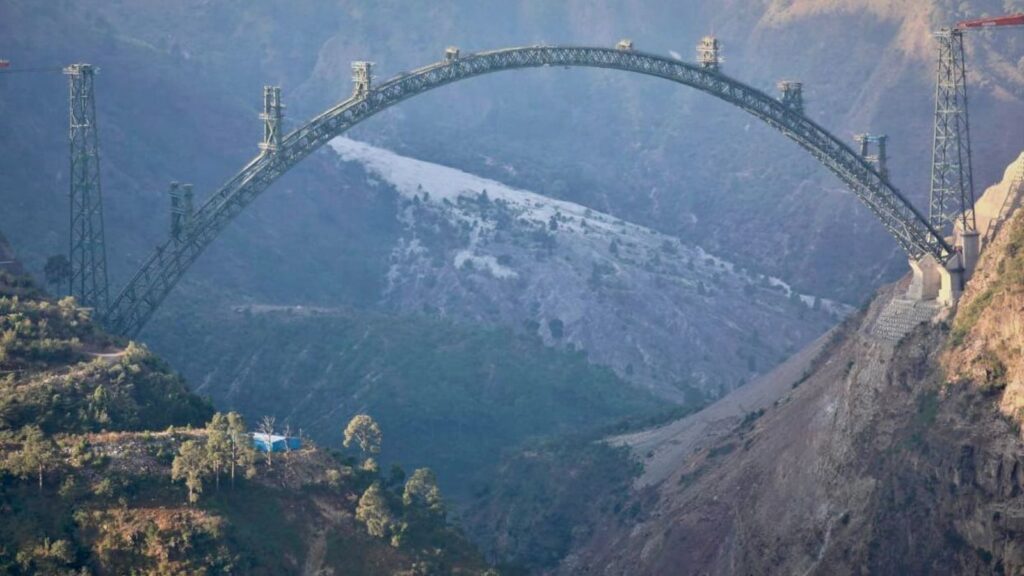The Chenab bridge is a 1,315 m-long railway bridge with a steel arch for the main span of 467 m, under construction in Jammu & Kashmir. It is a part of the Udhampur-Srinagar-Baramulla Rail Link (USBRL) project being undertaken by Indian Railways. Upon completion, the Chenab bridge will be the highest railway bridge in the world with its deck at 362 m above the high flood level. The alignment of the bridge is partly straight and partly on a combined transition curve and circular curve of 638.6 m radius in the approach viaduct. It has a design life of 120 years. The bridge is designed to withstand blasts.
Incremental launching of deck structure on combined circular and transition curve has been done here for the first time in the world and the world’s largest capacity crossbar cable crane has been used for the erection of piers, trestles and arch segments. For cable crane erection, indigenously developed climbing cranes are being used, the pylon is erected up to a maximum height of 50 metre using a self-supported tower crane, and the climbing cranes are erected by the tower crane onto the partly erected pylons. The climbing crane can erect one pylon module and uses the built module as a platform to ascend for one module length. For bridge construction, 10.9 grade M36 HSFG bolts with geomet coating are being used.
Apart from its record-setting height, the bridge has a long list of firsts to its credit. Installation of a double corrosion protected bar and cable anchors as well as extensive wind tunnel testing – topographic model study, section model study, and aero-elastic model study – have been done here for the first time in India along with the fatigue design and detailing of the bridge.

Conceptual design
As the bridge is in the vicinity of the snow-clad Himalayas mountains, which go to sub-zero temperatures, special steel was adopted to ensure the long life of the structure. Site-specific response spectrum was developed based on which dynamic analysis of the structure and ductile detailing were performed for the most seismically active area – Zone V.
In the sensitive border area, even after dislodging one critical member of the arch, the bridge can still carry traffic at a restricted speed. Additionally, even after the removal of one pier, the bridge will not collapse under its weight. The bridge design is based on wind tunnel tests; further, the bridge will be fitted with an instrumentation system to enable trains to stop if the wind speeds exceed 90 Kmph.
Incremental launching is a relatively modern type of bridge construction technique in which the bridge is incrementally constructed and launched from the approaches. Typically, bridges are constructed incrementally on straight or curved alignments with uniform radii. This is the first time in India that a bridge has been incrementally launched on a combined curve consisting of a transition curve and a circular curve. In this method of construction, the deck is built in accordance with the bridge’s alignment and is launched on a designed launching circular curve.
Due to the geological conditions of the area, (unstable slopes and erratic geology), detailed geotechnical and geological investigations and extensive slope stability analyses were carried out. All the designs were governed by wedge failure analysis. The slope stabilization measures adopted during the construction of the bridge were steel fiber-reinforced shotcrete, passive rock bolts of different lengths, active double corrosion protected bar, and cable anchors with a design life of 120 years below arch foundations and S60 foundation.
Challenges
Logistics management practices adopted at the site included a centralized transshipment yard at Reasi (nearest location for the access of the trailers from Jammu), plates and segment shifting from Reasi to the site, coordination with local authorities for the widening of the roads, elaborate heavy lifting and shifting arrangements. Due to narrow and sharp curve roads, transportation of the material at the site was the most challenging part of the project.
Due to sharp curves and narrow, underdeveloped roads, the movement of material through a 20-foot trailer was the only possible solution. Even so, only 20 mt of steel/fabricated components could be carried in one round.
The challenges faced in cable crane erection involved the erection of pylons of a maximum height of 128 meters and the threading of the ropes over the pylons crossing the river.
The safety challenges during arch erection were ensuring safe access to the erection site from the base of the arch, secure and stable working platforms at the erection point, and unfavourable weather conditions and wind speed.
To combat the difficulties and dangers of working at height, Chenab Bridge Project Undertaking (CBPU) has installed innovative life gear systems to provide safe access and a safe work platform. The workers have been supplied with green tags which allow them to work on scaffoldings certified by safety personnel. In an attempt to provide safe access to the erection site from the base of the arch, a fixed lifeline has been installed. It consists of a top bracket, a bottom bracket, and an 8 mm wire rope. It can prevent the fall of a person and support a load of 23 kNw





Leave a Reply